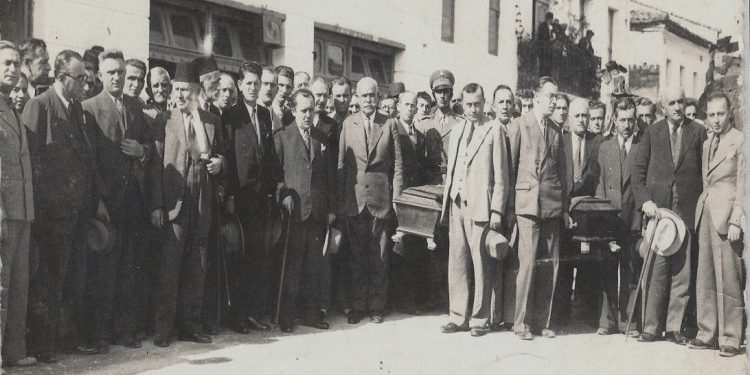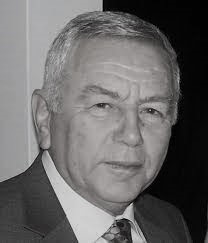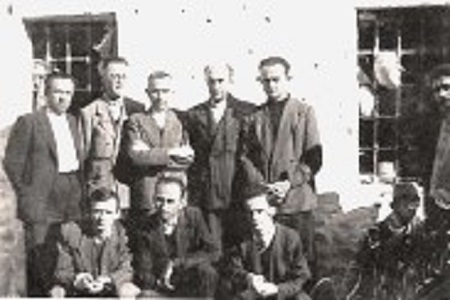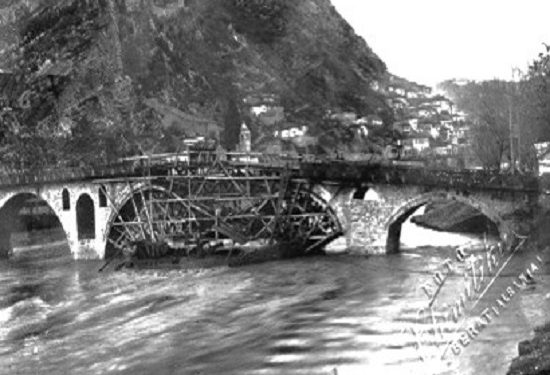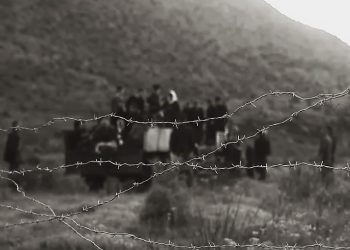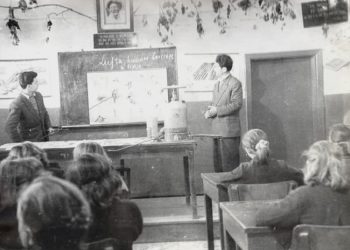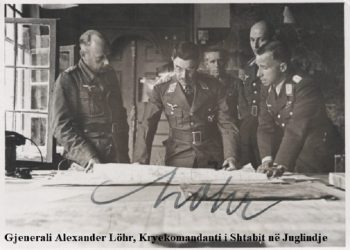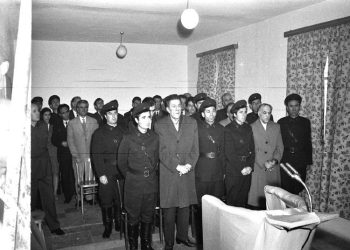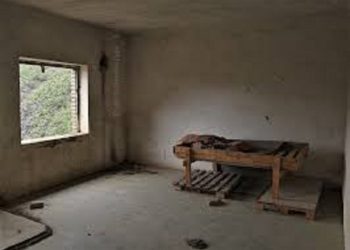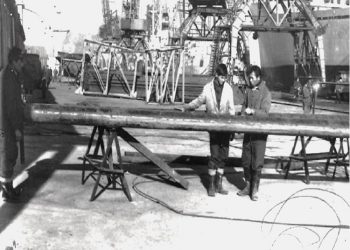By Qerim Vrioni
Memorie.al / Among the photographers of Berat, who have left deep traces in the history of the city in the last century, is Ilia Xhimitiku. Moreover, for the duration of his photographic activity, the level and the fields where he has practiced it, he undoubtedly occupies the first place among them. We mention that before him, Koçi Kusta and Naun Vruho had photographed there, who have served the community for a long time, but at the same time, “capturing” selected views of the city.
Later, these photos were printed on postcards (b/z), abroad, and today they can be found in various Albanian homes, not only in Berat. Berat, the 2400-year-old city, for its attractive views, was previously visited by foreign painters of the 19th century, such as the Englishmen Edward Lear and Charles Cockrell, who had created paintings there with different views of it. So, the city with its location and the way the houses were built, their connection with the relief, represented a permanent and special interest for artists. It seems right to think that, hardly any other way of building the city’s houses, would give Berat the charm of today.
Ilia Xhimitiku, or Lilo Xhimitiku, as the whole city called him for years and years, and he still remembers him today with this polished name, was born in the characteristic neighborhood, “Goricë”, of Berat, on July 20, 1907. His family at that time was engaged in trade. A special gift from his older brother, Milto, the “KODAK” camera (6X9), caused his first “touch” with the world of photography, a world that would keep him connected to his whole life and would provide him with a livelihood, but would also be a source of immense spiritual pleasures.
He began to learn photography from Palok Gurashi, then, military service in Shkodra gave him the opportunity to get to know the Marubës (Kel and Gegë) and other photographers from Shkodra. In 1929, Ilia Xhimitiku was licensed by the Berat Chamber of Commerce to publicly practice his photography skills (Gazeta “Milosao” – “Ura e Gorica në Berat, perse dohud restauruar” – by Genci Samimi and Dritan Çoku, -18 December 2010). A trip, in 1936, to Italy, enabled him to get acquainted with Italian civilization and culture (as much as a trip allows), but also to be equipped with cameras and materials for photography recently produced there.
Upon returning to his homeland, his work as a photographer improved, and therefore increased. We are mainly talking about portraits for citizens, a job with which he “supports the family”, but which he also carried out with care and skill. He does not forget to accompany the photos with one of the two stamps, the dry one, “Photo Xhimitiku-Berat (Albania)”, which he placed on the front of the photo, lower right, while the wet one, “Ilia Xhimitiku–Photographer Berat” on the back.
The routine activity in the shop, with commissioned portraits, does not prevent him from taking unsolicited documentary photos of Berat events outside of it, on occasions of family, religious, and social celebrations that would later make history. He pays special attention, especially to presenting the traditional clothing of the region in his photographs. Also, there are many photos of Xhimitiku that depict the characteristic occasional floods of the Osum River and the subsequent flooding of the city streets. From them, one can also understand a certain helplessness of the residents, in the face of the blind forces of nature.
Meanwhile, he is always on the hunt for new things in the city, such as visits by personalities, anniversaries, constructions and urban reconstructions, everything different from the daily life of a traditional city without industry and noisy metropolitan life, but with generous residents typical of harmony. This fact is also emphasized because in Berat, there were dozens of Orthodox churches and, just as many Muslim mosques, where believers practiced their religions, while respecting, at the same time, those of others. In the spirit of this peaceful coexistence, we think that there is also a landscape from the city, photographed from the upper part of the Gorica neighborhood.
A quick glance reminds you of Lear’s paintings; the photo has no tonal contrasts and is kept in the range (to use a term from painting). In fact, the lack of contrasts somewhat distances this shot from the status of a postcard. The photo immerses you in the atmosphere of the time of an uneventful city and has a warm romanticism. In other photos, he has tastefully used tonal contrasts. This is especially noticeable in some “shots” of the narrow alleys of the characteristic neighborhoods, “Mangalem” and “Goricë”, they receive indirect lighting from the sunlight that falls on the white walls of the houses.
Among Xhimitiku’s documentary photos, we can mention “The erection of the bust of “Babë Duda” (1937), the reconstruction of the Gorica Bridge (1938), the formation of the Democratic Government (October 1944), Khrushchev’s visit (1959) (“Shekulli” Newspaper – Lilo Xhimitiku – a photographer for Berat in the 1930s” – by Sulo Gozhina, 02.7.2007). Another photo by Xhimitiku, documentary and historical, shows a group of political prisoners in Berat, in 1945. Two of them, Namik Meqemeja and Resul Dollani (Toxhari), young men, around 20-22 years old, were executed shortly after, an event that shocked a large part of the city’s inhabitants.
However, by looking closely at those photographic specimens that have “survived” in the hands of his admirers, it can be said that he easily mastered elements of the language of photography, such as framing, light-shadow, angle of view, contrasts. In landscapes, it is noticeable that he tastefully chooses the point where he places the camera, so that the view, in this way, reveals the special, which an ordinary eye does not distinguish. Enough, Lilo Xhimitiku’s photos were also printed as postcards, although they often exceeded that designation.
He mainly photographed with films, but sometimes in the studio (shop) he also used the technology with glass plates, especially in the first years of activity for the population. Also, we remember that his photographs are black and white, but also in sepia, although not often. Lilo Xhimitiku, helped with his experience, around the 60s and 70s, in the opening of photography sectors (in municipal enterprises) in Përmet, Lushnje, Fier, Çorovodë, Gramsh, but it should be especially noted that in the years 1956-57, he took the initiative to establish a group of small photographers, near the Pioneer House of the city.
Among the documentary photos, now of great historical value by Xhimitiku, is the one briefly titled, “Berat, 1936”. In that year, the remains of patriots Çerçiz Topulli and Muço Qulli, treacherously killed by Montenegrin chauvinists in the outskirts of Shkodra in 1915, were moved to their birthplaces. On the way from the northern city to Gjirokastër, the procession with the caskets also made a stop in Berat, where they were given a well-deserved honor in the Municipality. The people of the city, with their numerous homages to the two martyrs of Albanianism, demonstrated, in addition to their patriotic spirit, their characteristic civilization. Xhimitiku has frozen the moment of the caskets being escorted from the Municipality in the photograph we are examining, but also in several other photos until the procession left the city. We think that this photo speaks of the patriotism and citizenship of Berat, much more than many speeches and declarations.
The study and analysis of Xhimitiku’s work is done by carefully looking at the photographs that have survived to our days, which, according to rough calculations, constitute about 10% of his entire creativity. A frightening, small number. This is due to three serious disasters that have plagued his fund. First, on September 13, 1944, his house in Gorica burned down, along with the archive, second, a storm destroyed his studio in February 1954, and third, the floods of the Osum River in 1962 flooded the archive and studio, destroying printing equipment and devices, unused photos and paper, chemicals, etc., causing colossal irreparable losses (Gazeta “Tema” – “French bring “Marubin” to Berat” – by Abedin Kaja and Xhovani Shyti-03.7.2007)).
To these, we must add many photos that Lilo Xhimitiku himself has removed, with people and events that were unpleasant for the regime; for fear that they could serve as “corpus delicti” for persecution. Many photos of a political nature, such as Lilo’s visits to state figures, have been repeatedly published in the press, but without the author’s name. We also note that he has also taken many interesting portraits of acquaintances in their family environments, immortalizing their psychology on photographic paper. Even in these shots, he does not like strong contrasts.
Ilia Xhimitiku also taught the art of photography to his two sons, who took photographs for a long time, but without reaching their father’s level. Ten years after his retirement, Ilia Xhimitiku, a symbolic photographer of Berat, passed away in his home in the “Goricë” neighborhood, in 1977. The full honors of his funeral to his last home showed the respect and love of his fellow citizens for him.
We are fully convinced that a large part of Ilia Xhimitiku’s creativity is in the old Berat families, which in the not-so-distant future can be gathered by the city’s “Lear Gallery”, which, however, should not be criticized for its lack of activities. This would constitute a duty to give Ilia Xhimitiku the honorable place that belongs to him not only in the history of Berat, but also in that of Albanian photography, and his work would be revealed with all its values. /Memorie.al




